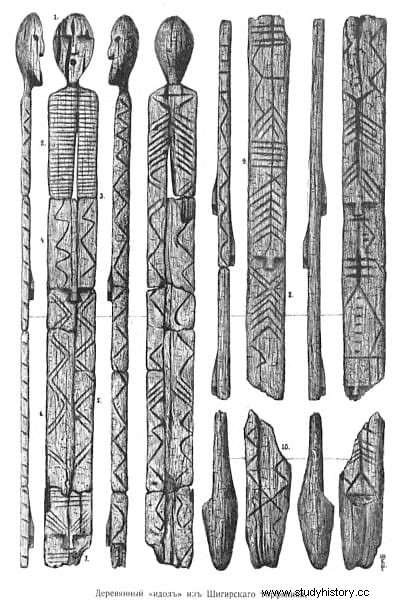The wood it is flimsy and perishable. There are hardly any objects of this material left from other eras from the Middle Ages backwards, let alone in Prehistory So when one is found, Archeology is in luck. And if on top of that it is a piece like this idol, even more so.
It was found in 1894 in a peat bog in the Ural Mountains Siberians and is estimated to be around nine thousand five hundred years , which is why it is considered the oldest surviving wooden statue. Known as the Shigir Idol by the name of the swamp where it rested, it is currently exhibited in the Ekaterinburg Museum (Russia) inside a glass capsule that guarantees adequate preservation conditions.

But it turns out that the idol could be much more than that. Svetana Savchenko , who directs the museum section where it is exhibited, believes that this anthropomorphic figure has carved a kind of codified narration about the creation of the world, according to the beliefs of its Mesolithic manufacturers .
The problem is that the idol was removed chopped -it was four meters deep, safe from microorganisms- and the recomposition of the pieces has been a real puzzle for experts over the years, with the added difficulty of missing fragments.
Because, apart from the human head, the body -flat and rectangular- shows different symbols and pictograms they follow each other on its surface and nobody believes that it is a mere geometric decoration. There are straight horizontal lines that could be equivalent to ribs but that some archaeologists venture to identify with the earth, the horizon or the border between this world and the spiritual one; other lines, wavy or zig-zag, could represent water or some reptile; polygons and crosses, fire or the sun, etc.

For her part, Savchenko and her team at the museum believe, indeed, that the straight lines are land and the wavy ones are sea, so the idol would constitute a whole naval map in which the directions are indicated with arrows and a calendar of the necessary days for the trip appears. There are also those who see an entire cosmogony, a pantheon of gods or spirits whose hierarchy would be embodied in their faces -there are seven- distributed vertically. Its location in the front or back of the piece would allude to a duality of worlds different.
In reality there is no consensus and each researcher proposes his own theory, although they do seem to agree in considering the decoration of such an extraordinary object as a kind of primitive writing . Determined to decipher it, the archaeologists think that they will be able to publish the first results in the initial months of 2015 .
In short, a scientific mystery manifested not only in the alleged code but also in the piece itself, since the original reconstruction, carried out by Professor Dimitri I. Lobanov and which resulted in an idol of two meters and eighty centimeters high, was answered by other experts who demanded to add discarded pieces. Unfortunately, these were lost in the Russian civil war of the twenties and only the drawings remain. of the archaeologist Vladimir Tolmachev; if these pieces really belonged to the idol, it would reach an impressive height of more than five meters .
Another enigma that raises controversy is whether the idol is designed to be placed upright and nailed to the ground or would have supported against a tree or wall. Again there are opinions for all tastes. The only data that seems certain is that provided by scientific technology:a mass spectrometer revealed that it was made of larch wood; the ring count yielded an age indicating that the tree was over a century and a half old when it was felled.
